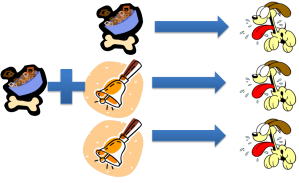Atypical Behaviour
A* - G syllabus
- Created by: Thunder12
- Created on: 08-04-18 19:53
Key Concepts
Typical behaviour: a behaviour that is expected, and considered to be normal
Atypical behaviour: a behaviour considered abnormal, usually a minority of people
Phobia: an atypical fear response given the object or situation
- Agoraphobia: An extreme fear of being in public spaces away from the safety of home
- School phobia: an extreme fear of attending and being in school
- Social phobia: an extreme fear of being exposed or embarrassed during social contact
- Acrophobia: an extreme fear of heights
- Arachnophobia: An extreme fear of spiders (most common animal phobia)
Core Theory
Learning by association – people learn to associate a particular response with a particular stimulus
Based on Pavlov’s dog experiment
- When the food is presented (Unconditioned Stimulus) the dog salivates (Unconditioned Response)
- The food (US) is then paired with a bell (Neutral Stimulus) and the dog still salivates because the food is there (Unconditioned Response)
- In time, the dog will salivate with the noise of the bell alone. The bell becomes a Conditioned Stimulus and the salivation is now a Conditioned Response – the dog has learnt that the bell means food will come so starts to salivate.
Can be generalised to other similar stimuli
Extinguished (got rid of) over time, usually when fear is ‘faced’
Core Theory

Criticisms of the Core Theory
Behaviourist theory
- Ignores the mind and the thinking behind the behaviour
- Assumes we need direct experience with the feared object – some others argue we can learn it indirectly
- Cannot explain the idea that some people have phobias of objects they have no direct or indirect experience of
- Can be tested scientifically and reliably in lab experiments
- Can be used to treat phobias by removing them through positive associations
Alternative Theory
Evolutionary Theory -
- Fear is instinctive because it helps us to survive.
- If we had no fear, we would put ourselves in dangerous situations that could kill us.
- Certain objects or situations are more threatening to our survival than other.
- We are more likely to fear animals least like ourselves in shape and form.
- Evolutionary theory does not say we are born with their phobias. It says we are born with a biological preparedness to fear certain things more than others as they are a greater threat to our survival.
Core Study
Aim: To study classical conditioning of fear of a white rat using ‘Little Albert’ 9 month old baby
Procedure:
- Tested for reactions to neutral stimuli
- Live animals, burning newspaper, cotton, human masks he had no fear to these
- When Albert reached for a white rat (NS) they banged a steel bar behind the baby to make a loud noise (US) and scare him (UR).
Results
- After seven pairings the rat was enough to frighten Albert even though it had not done so before.
- Five days later, fear was tested again-still persisted. Albert was also afraid of a rabbit, a dog, a sealskin coat(fluffy), a Santa mask and even Watson’s hair (which was white)
- Ten days later – some fear still there.
- One month later – mild fear, and Albert’s mother withdrew him
Conclusions: You can condition fear into a human using classical conditioning, and the fear can be generalised to similar objects.
Criticisms of the Core Study
Generalisability: Small sample size of only one child – hard to generalise outside of this sample
Reliability: Well structured and controlled experiment, although no direct video evidence of the conditioning, so hard to replicate easily
Application: This can be used to develop phobia therapies, by pairing the stimulus with a positive experience to form new associations
Validity: Ecologically not very valid, as a lab experiment, although Albert was used to being in the hospital nursery as his mother worked there.
Ethics: Very bad ethically – it caused a great deal of distress to Albert, causing harm to the participants. His mother did withdraw him from the experiment, however W&R didn’t remove the fear before this, which is unethical.
Applications
Systematic desensitisation.
- The person with a phobia develops an anxiety hierarchy that describes situations with the thing they are scared of, ranging from low to high in terms of their fear rating.
- The therapist then works through each stage in real life with the patient, teaching them relaxation techniques to cope with the situation and for them to feel a more positive association with the thing that scares them.
- Bit by bit they work up the pyramid, practising their relaxation techniques and eventually conquer their fear.
Related discussions on The Student Room
- Doctors advice uk »
- scared i wont get acom - uni of birmingham »
- What TV show are you currently watching? »
- I got all 9s at GCSE Ask me Anything »
- First year workload »
- Need advice (I think i might have autism) »
- Withdrew from Oxford(health)- reapplying to similar course at Cambridge(mature) »
- Any Netflix recommendation? »
- possible careers »
- essay help!!!!!!!!! mock on friday »
Comments
No comments have yet been made